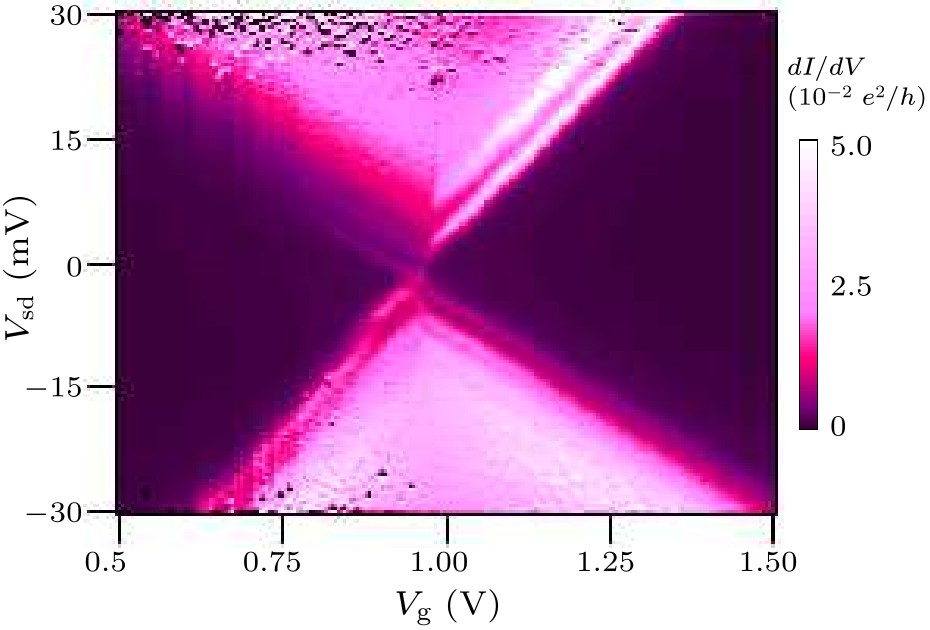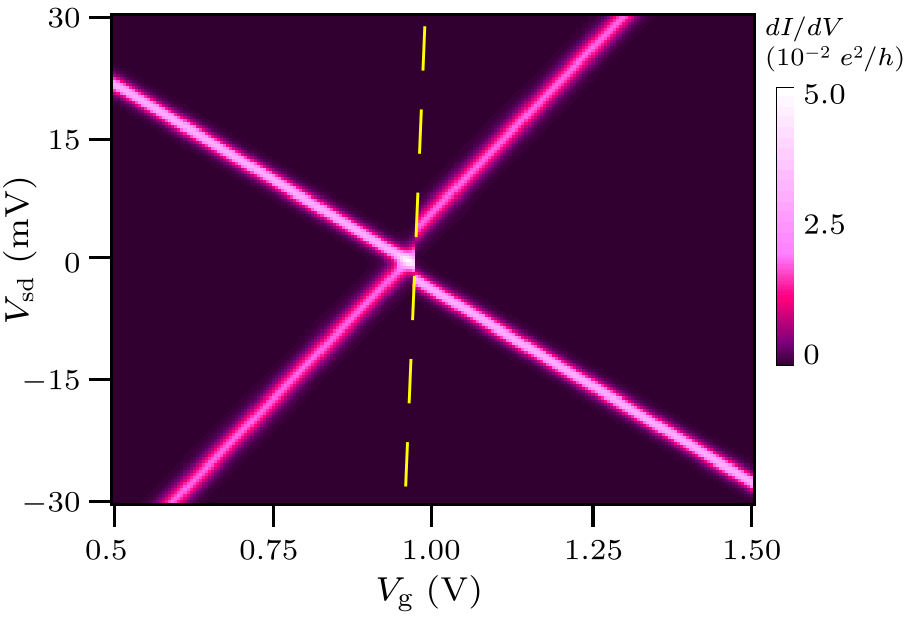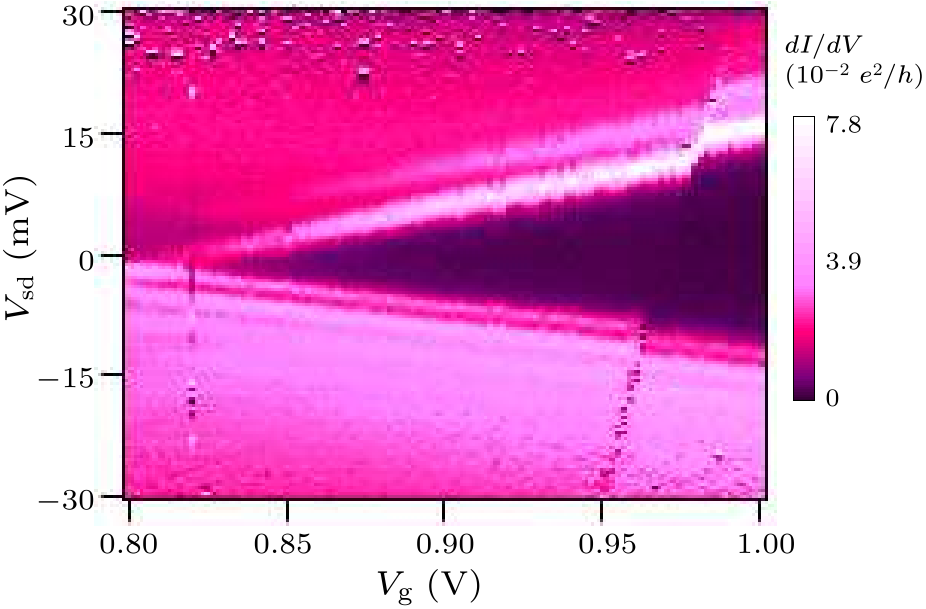
Fig. 1. (a) Schematic diagram of a single molecule device with an extra molecule aside. (b) Equivalent circuit diagram of the device in (a). (c) SEM image of the device after breaking.

Fig. 2. Color plot of differential conductance ($dI/dV$) as functions of bias voltage ($V_{\rm sd})$ and gate voltage ($V_{\rm g})$ for a single C$_{60}$ molecule transistor. Here $e$ is the electron charge and $h$ is Planck's constant.

Fig. 3. Color plot of differential conductance ($dI/dV$) as functions of bias voltage ($V_{\rm sd})$ and gate voltage ($V_{\rm g})$ for a single C$_{60}$ molecule transistor with an extra molecule aside.

Fig. 4. Two-dimensional differential conductance map calculated by rate equation using the model in Fig. 1(b). The charge switching boundary is marked by the yellow dashed line.

Fig. 5. Two-dimensional differential conductance map for the same device of Fig. 3 after thermal stimulate.
| [1] | Aradhya S V and Venkataraman L 2013 Nat. Nanotechnol. 8 399 | Single-molecule junctions beyond electronic transport
| [2] | Song H, Reed M A and Lee T 2011 Adv. Mater. 23 1583 | Single Molecule Electronic Devices
| [3] | Tao N J 2006 Nat. Nanotechnol. 1 173 | Electron transport in molecular junctions
| [4] | Xiang D et al 2016 Chem. Rev. 116 4318 | Molecular-Scale Electronics: From Concept to Function
| [5] | Perrin M L, Burzuri E and van der Zant H S 2015 Chem. Soc. Rev. 44 902 | Single-molecule transistors
| [6] | Scott G D and Natelson D 2010 ACS Nano 4 3560 | Kondo Resonances in Molecular Devices
| [7] | Osorio E A et al 2008 J. Physics. Condens. Matter: An Inst. Phys. J. 20 374121 | Single-molecule transport in three-terminal devices
| [8] | Liang W J et al 2002 Nature 417 725 | Kondo resonance in a single-molecule transistor
| [9] | Kubatkin S et al 2003 Nature 425 698 | Single-electron transistor of a single organic molecule with access to several redox states
| [10] | Marquardt C W et al 2010 Nat. Nanotechnol. 5 863 | Electroluminescence from a single nanotube–molecule–nanotube junction
| [11] | Kim Y et al 2014 Nat. Nanotechnol. 9 881 | Electrostatic control of thermoelectricity in molecular junctions
| [12] | Thiele S Thiele et al 2014 Science 344 1135 | Electrically driven nuclear spin resonance in single-molecule magnets
| [13] | Martínez-Blanco J et al 2015 Nat. Phys. 11 640 | Gating a single-molecule transistor with individual atoms
| [14] | Wu S et al 2008 Nat. Nanotechnol. 3 569 | Molecular junctions based on aromatic coupling
| [15] | Park H et al 2000 Nature 407 57 | Nanomechanical oscillations in a single-C60 transistor
| [16] | Yu L H and Natelson D 2004 Nano Lett. 4 79 | The Kondo Effect in C 60 Single-Molecule Transistors
| [17] | Winkelmann C B et al 2009 Nat. Phys. 5 876 | Superconductivity in a single-C60 transistor
| [18] | Park H et al 1999 Appl. Phys. Lett. 75 301 | Fabrication of metallic electrodes with nanometer separation by electromigration
| [19] | Prins F et al 2011 Nano Lett. 11 4607 | Room-Temperature Gating of Molecular Junctions Using Few-Layer Graphene Nanogap Electrodes
| [20] | Yu L H et al 2004 Phys. Rev. Lett. 93 266802 | Inelastic Electron Tunneling via Molecular Vibrations in Single-Molecule Transistors
| [21] | Galperin M, Ratner M A and Nitzan A 2007 J. Phys.: Condens. Matter 19 103201 | Molecular transport junctions: vibrational effects
| [22] | Osorio E A et al 2007 Adv. Mater. 19 281 | Addition Energies and Vibrational Fine Structure Measured in Electromigrated Single-Molecule Junctions Based on an Oligophenylenevinylene Derivative
| [23] | de Leon N P et al 2008 Nano Lett. 8 2963 | Vibrational Excitation in Single-Molecule Transistors: Deviation from the Simple Franck−Condon Prediction
| [24] | Petit P et al 2014 Phys. Rev. B 89 115432 | Universality of the two-stage Kondo effect in carbon nanotube quantum dots
| [25] | Hofmann F et al 1995 Phys. Rev. B 51 13872 | Single electron switching in a parallel quantum dot
| [26] | Abulizi G, Baumgartner A and Schönenberger C 2016 Phys. Status Solidi B 253 2428 | Full characterization of a carbon nanotube parallel double quantum dot
| [27] | Beenakker C W J 1991 Phys. Rev. B 44 1646 | Theory of Coulomb-blockade oscillations in the conductance of a quantum dot
| [28] | Mahapatra S, Buch H and Simmons M Y 2011 Nano Lett. 11 4376 | Charge Sensing of Precisely Positioned P Donors in Si